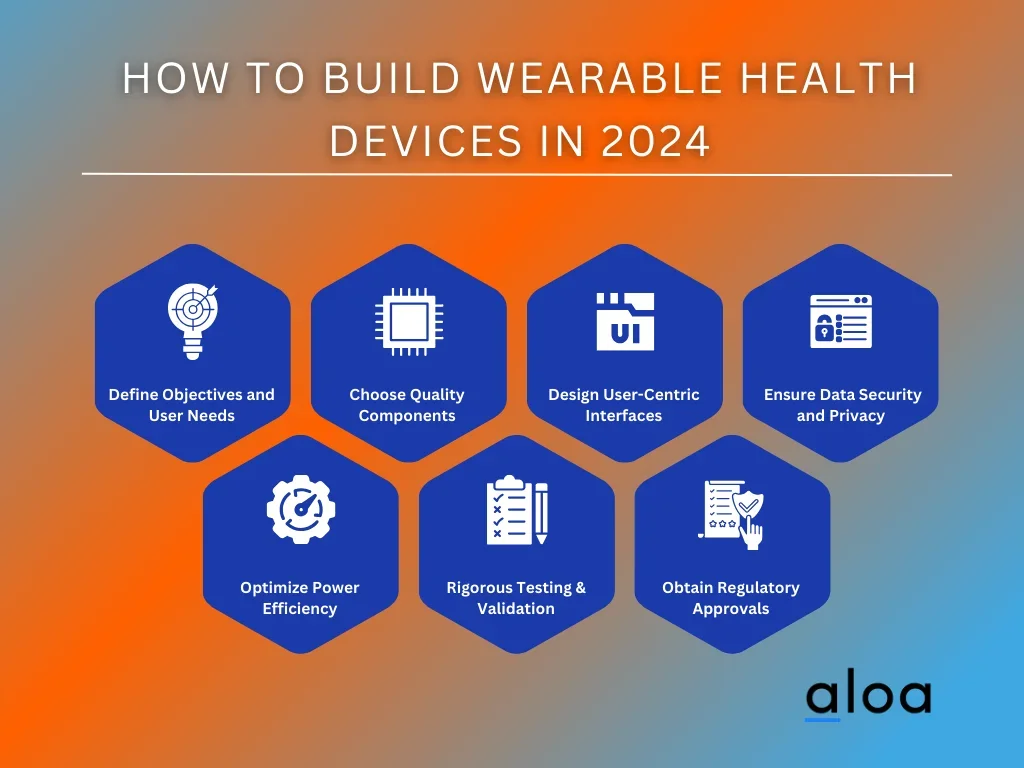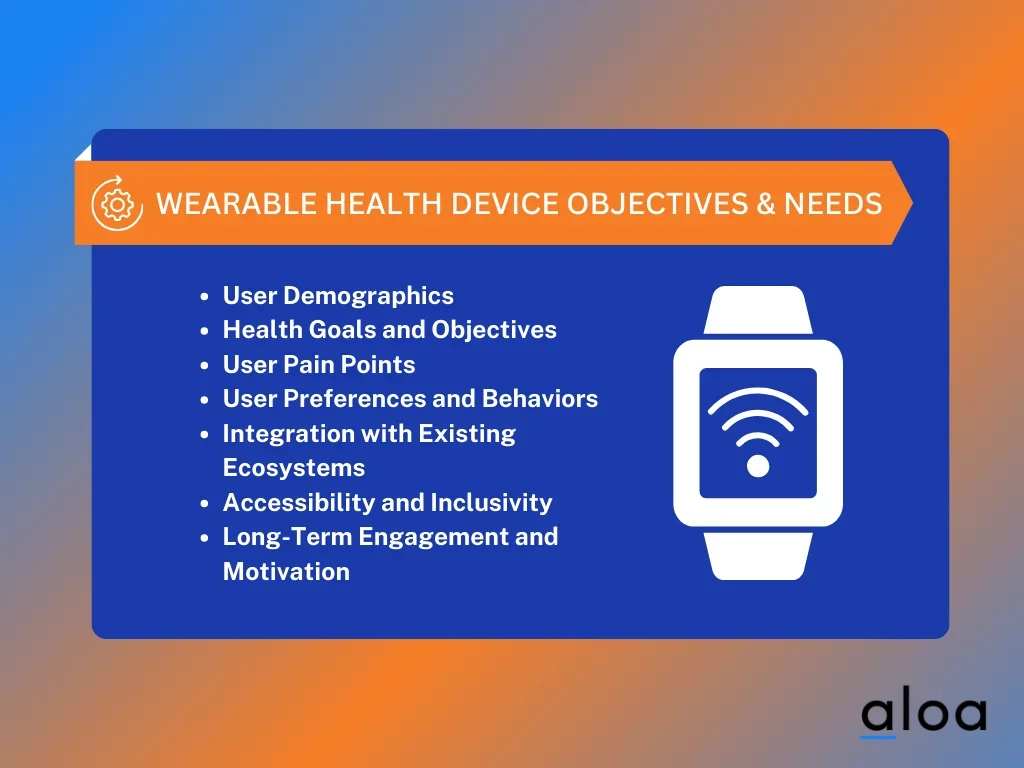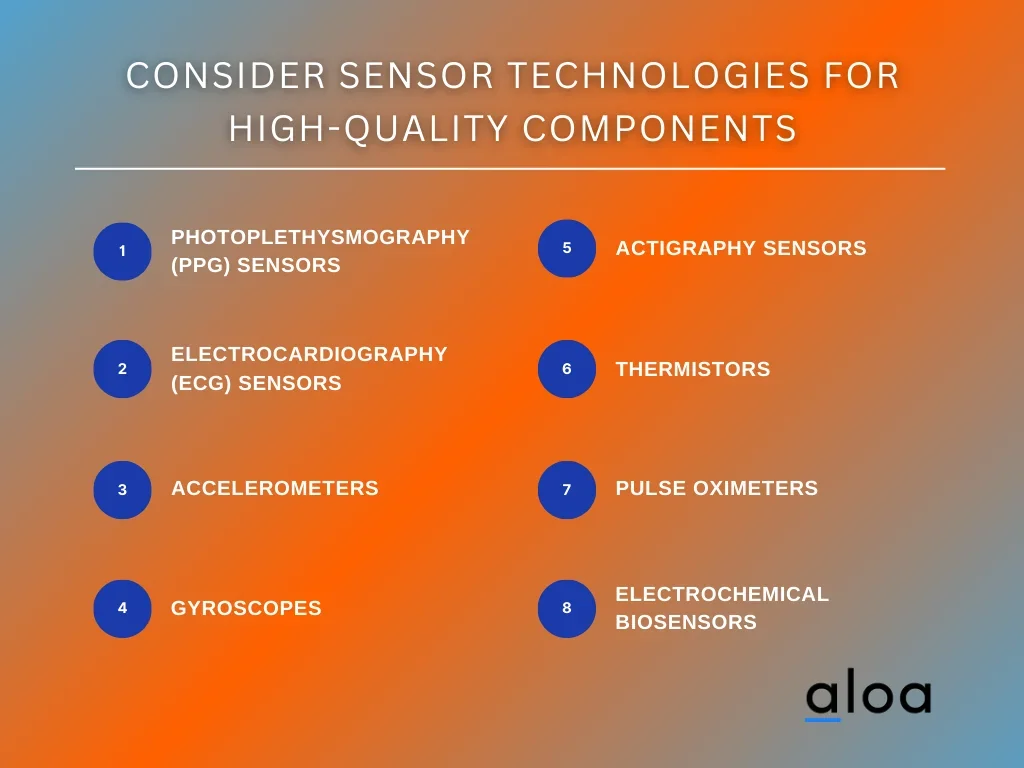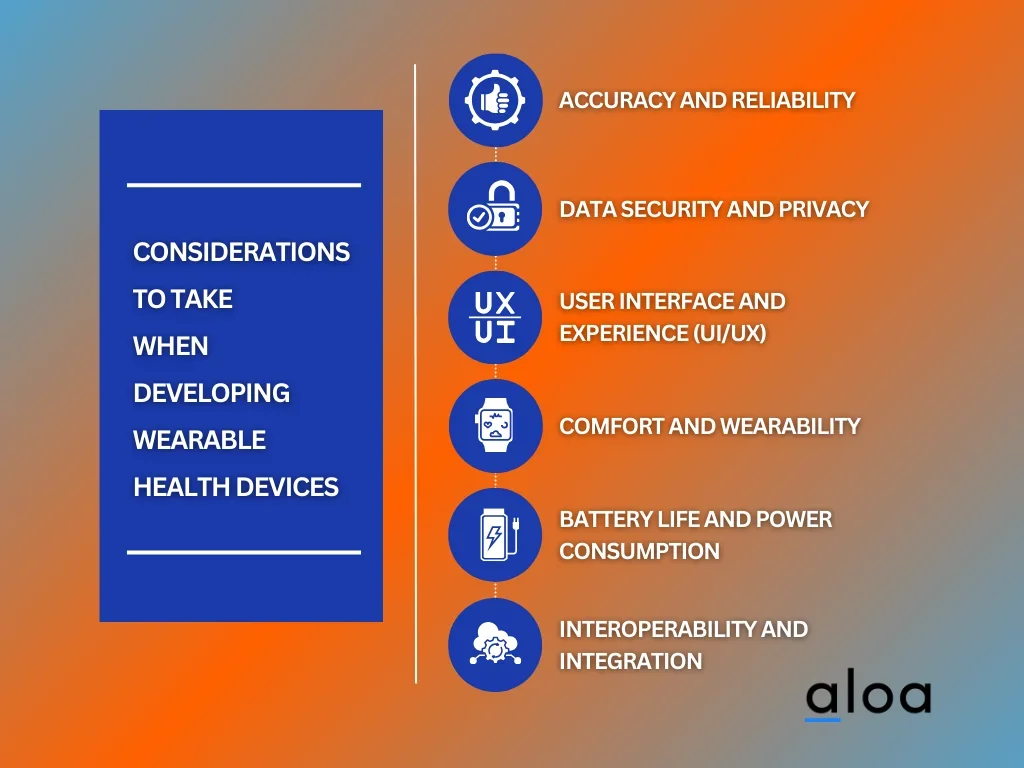Building wearable health devices is one of the emerging trends in the healthtech industry, making it crucial for software developers and startups. These devices enable real-time health monitoring, personalized treatment plans, and proactive interventions, empowering individuals to manage their health effectively. Navigating this market offers developers and startups opportunities for innovation, collaboration, and new revenue streams.
At Aloa, we recognize the transformative benefits of building wearable health devices, which are crucial and beneficial for software development and startups. Leveraging our expertise in software outsourcing, we've guided startups and software companies to stay updated with trends in healthcare technology like this. The ongoing development of these devices not only facilitates enhanced patient monitoring but also fosters the creation of personalized healthcare solutions.
In this blog, we will dive into the process of developing wearable health devices. We will explore the stages involved, discussing the key considerations and essential features for users and developers. Afterward, you will gain insights into how these devices can significantly improve healthcare outcomes and enhance user experiences in 2024.
Let’s jump in!
How to Build Wearable Health Devices in 2024
Developing wearable health devices requires careful attention to enhance design, functionality, and user experience. Explore our comprehensive guide on building wearable health devices to gain valuable insights and practical strategies for success in this rapidly evolving field. Here are the steps to guide you through the process:

Step 1: Define Objectives and User Needs
Start by clearly defining the goals and objectives of your wearable health device, especially in the early stages. Determine the specific health metrics it will monitor, such as heart rate, sleep patterns, physical activity, or stress levels.
Additionally, conduct thorough market research to understand your target users' needs, preferences, and pain points, especially in the early stages of development. For a more in-depth understanding of this step, here are some of the factors that you may consider:

- User Demographics: Understand the demographic characteristics of your target users, including age, gender, occupation, and socioeconomic status, to tailor the wearable device to meet individual needs and promote engagement in managing their health.
- Health Goals and Objectives: Identify the primary health goals and objectives your target users aim to achieve with the help of your wearable device.
- User Pain Points: Identify the challenges, frustrations, and limitations that users currently face in managing their health and wellness through conducting surveys, interviews, and focus groups.
- User Preferences and Behaviors: Explore user preferences, habits, and behaviors related to health monitoring and wearable technology usage.
- Integration with Existing Ecosystems: Consider how your wearable health device will integrate with existing health and wellness ecosystems, including mobile apps, fitness platforms, Electronic Health Records (EHRs), and telemedicine services. Platforms like FitBudd personal training software — which offers tools such as a gym CRM software and AI workout builder for trainers — are great examples of how wearables can connect with fitness apps to enhance client engagement and results.
- Accessibility and Inclusivity: Ensure your wearable health device is accessible and inclusive to users with diverse needs and abilities. Consider factors such as readability, language support, audio feedback, tactile feedback, and adjustable settings to accommodate users with visual, auditory, motor, or cognitive impairments.
- Long-Term Engagement and Motivation: Explore strategies to promote long-term engagement and motivation among users to sustain healthy behaviors and adherence to monitoring routines.
Step 2: Select High-Quality Components and Sensors
Once objectives are set, including addressing the needs of individuals with chronic conditions, choose reliable components and wearable sensors for accurate vital sign data collection and robust performance. Prioritize sensor accuracy, sensitivity, response time, and durability to ensure effective long-term health monitoring.
In addition, evaluate different sensor technologies and connectivity options (e.g., Bluetooth, Wi-Fi, cellular) to determine the best fit for your device's requirements and user experience in remote monitoring scenarios. Here are some sensory technologies that you may consider for selecting high-quality components and sensors:

- Photoplethysmography (PPG) sensors: These sensors measure heart rate by detecting changes in blood volume through optical sensors. They are commonly used in wrist-worn devices like smartwatches and fitness trackers.
- Electrocardiography (ECG) sensors: ECG sensors measure the heart's electrical activity to provide more accurate heart rate data and detect irregular heart rhythms. They are often integrated into chest straps or patches for medical-grade monitoring.
- Accelerometers: Accelerometers measure movement and orientation changes, allowing for accurate tracking of physical activity, steps taken, and sleep patterns. They are essential for monitoring activity levels and providing insights into daily movement habits.
- Gyroscopes: Gyroscopes complement accelerometers by measuring rotation and angular velocity, providing additional context for activity tracking and motion analysis.
- Actigraphy sensors: Actigraphy sensors use accelerometers to monitor movement patterns during sleep, providing insights into sleep duration, quality, and disruptions. They are commonly integrated into medical wearables to track sleep stages and assess sleep health.
- Thermistors: Temperature-sensitive resistors measure temperature changes and provide real-time temperature data. They are used for monitoring body temperature, ambient temperature, and environmental conditions relevant to health and well-being.
- Pulse oximeters: Pulse oximeters measure blood oxygen saturation levels by analyzing light absorption in arterial blood. They are increasingly integrated into wearable devices to monitor respiratory rate and oxygen levels in real time, especially in situations like sleep apnea or high-altitude activities.
- Electrochemical Biosensors: They are commonly used for monitoring glucose levels in diabetic patients and detecting other analytes relevant to health monitoring. Through biosensor technology, electrochemical biosensors enable precise, real-time biomarker measurement for accurate health assessments.
Step 3: Design User-Centric Interfaces
Developing user-centric interfaces prioritizing ease of use, readability, and accessibility is the next key crucial step. Design intuitive navigation flows and visually appealing displays to present health data in a clear and understandable format.
Consider user feedback and usability testing throughout the design process to refine the interface and optimize user interaction. Here are some essential factors to consider when designing a user interface, crucial for enhancing the user experience and promoting engagement with wearable health technology:
- Develop Intuitive Interfaces: Create interfaces prioritizing ease of use, readability, and accessibility. Design intuitive navigation flows and visually appealing displays to present health data clearly and understandably.
- Consider User Feedback and Usability Testing: Throughout the design process, incorporate user feedback and conduct usability testing to refine the interface and optimize user interaction.
- Clarity and Simplicity: Keep the interface clear, simple, and easy to navigate, minimizing user complexity.
- Consistency and Familiarity: Maintain consistent design elements and patterns familiar to users of wearable devices and mobile apps, promoting ease of use and familiarity.
- Customization and Personalization: Enable users to personalize settings and layouts based on their preferences and health goals, enhancing engagement and usability.
- Responsive Design: Ensure the interface adapts seamlessly to different device sizes and input methods, providing a consistent user experience across various platforms and devices.
- Accessibility and Inclusivity: Implement features to accommodate users with diverse needs, such as screen reader compatibility and adjustable settings, fostering inclusivity and accessibility.
- Feedback and Guidance: Provide clear feedback and guidance to users through visual cues and notifications, reinforcing actions and progress and enhancing user engagement.
- Data Visualization and Interpretation: Present health data visually using charts and graphs to make trends and insights easily understandable, empowering users to interpret and act upon their health information effectively.
Step 4: Ensure Data Security and Privacy
Afterward, implement robust security measures to protect sensitive health data from unauthorized access, tampering, or breaches. Incorporating strong encryption and secure storage methods to safeguard user data is essential. Clear privacy policies should be established, and user consent for data collection must be obtained.
Regular software and firmware updates are necessary to address any security vulnerabilities effectively. Collaborating with cybersecurity experts can further ensure the highest level of user data protection and enhance such devices' overall security posture.
Step 5: Optimize Power Efficiency
Focus on optimizing power consumption to extend battery life and enhance user convenience. Employ energy-efficient hardware designs, low-power components, and power management techniques to minimize energy consumption without compromising device performance.
Moreover, implement sleep modes, idle timeouts, and other power-saving features to maximize battery longevity and usability between charges. Integrating energy-saving techniques ensures that devices remain operational for extended periods, empowering users to monitor their health effectively without frequent interruptions for recharging.
Step 6: Conduct Rigorous Testing and Validation
Conducting comprehensive testing and validation of your wearable health device is crucial to ensure its functionality, accuracy, and reliability under various conditions. Simulate real-world environments and conditions during testing and validate if it involves comparing device data to established medical standards.
Furthermore, involving healthcare professionals and end-users in the testing and validation process is essential for gathering comprehensive feedback and insights, which contribute to the development of high-quality wearable health devices.
Step 7: Obtain Regulatory Approvals and Certifications
Lastly, navigate the regulatory landscape and obtain necessary approvals and certifications to market and distribute your wearable health device legally. Understand and comply with your target markets' medical device regulations, data privacy, and consumer safety.
Additionally, prepare and submit regulatory documentation, including technical specifications, risk assessments, and clinical data, as required by regulatory authorities such as the FDA (Food and Drug Administration) or CE (Conformité Européenne). Collaborate with regulatory experts and legal counsel to navigate the process efficiently and mitigate compliance risks.
Essential Features of Wearable Health Devices
When designing wearable health devices, it's crucial to focus on accuracy and usability to address various health issues effectively. The necessary features may vary depending on the device's intended purpose and the demographics of its users. Here are essential considerations to remember when developing wearable health devices:

Admin Side Features of Wearable Health Devices
Administrators are crucial to ensuring the seamless integration and effective management of wearable health devices within healthcare systems. These devices cater to patient monitoring, data collection, and remote healthcare delivery. These devices have various features designed specifically to meet administrators' needs:
- Data Monitoring and Analytics: Admins can access a dashboard or platform to monitor data collected by wearable devices. This includes heart rate, activity levels, sleep patterns, and more.
- Patient Management: Admins can manage patient profiles remotely, including assigning devices, setting thresholds for health parameters, and monitoring adherence to treatment plans.
- Alerts and Notifications: Admins can receive alerts and notifications in real-time when patients' health parameters exceed predefined thresholds or deviations from normal patterns.
- Data Integration and Export: Integrating electronic health records (EHR) systems allows admins to integrate wearable device data smoothly with patients' medical records. They can also export data for further analysis or research purposes.
- Customization and Configuration: Admins can customize settings and configurations of wearable devices based on individual patient needs or research requirements, anticipating future potential developments in wearable technology and healthcare delivery.
- Compliance and Security: Admin features often include tools for ensuring compliance with healthcare regulations (such as HIPAA) and maintaining the security and privacy of patient data, which is crucial for upholding public trust and supporting public health initiatives.
User Side Features of Wearable Health Devices
When building wearable health devices with users in mind, it's crucial to emphasize comfort, convenience, and user-friendliness. Users should feel at ease using the device in their daily routines, ensuring smooth integration into their lifestyle. Here are key features to prioritize for users:
- Activity Tracking: Wearable devices track various activities such as steps taken, distance traveled, calories burned, and floors climbed.
- Heart Rate Monitoring: Continuous or periodic heart rate monitoring gives users insights into their cardiovascular health and fitness levels.
- Sleep Tracking: Users can monitor their sleep patterns, including duration, quality, and stages of sleep, to improve sleep hygiene and overall well-being.
- Stress Monitoring: Some wearable devices offer features to monitor stress levels based on heart rate variability or other biometric data.
- Fitness Coaching and Feedback: Users may receive personalized coaching tips, feedback, and recommendations based on their activity levels, goals, and progress.
- Health Reminders and Notifications: Wearable devices can remind users to stay active, take medication, drink water, or perform other health-related tasks throughout the day.
- Integration with Mobile Apps: Many wearable health devices integrate with mobile apps, allowing users to view their data, set goals, track progress, and receive insights on their smartphones or tablets, facilitating remote patient monitoring by enabling easy access to health data and communication with healthcare providers.
- Water Resistance and Durability: Wearable devices designed for health and fitness often feature water resistance and durability, allowing users to wear them during various activities and environments.
Considerations to Take When Developing Wearable Health Devices
Ensuring their effectiveness, usability, and scalability in healthcare settings is crucial when developing wearable health devices. Whether you're designing a wearable device for individual users or integrating it into healthcare systems, these considerations tailor solutions to meet patient and professional needs. Here are some key considerations:

Accuracy and Reliability
In developing wearable health devices, ensuring accuracy and reliability is paramount. Consistent, precise data measurement is essential, requiring regular calibration and testing. A reliable power source is crucial to prevent malfunctions, while external factors like motion and temperature variation must be considered.
Data Security and Privacy
Top priorities for wearable health devices, data security and privacy must comply with regulations like HIPAA to safeguard sensitive health information. Encryption and secure data storage are crucial for user data protection, and routine security audits help identify and address vulnerabilities. Transparency and clear user consent policies build trust with consumers.
User Interface and Experience (UI/UX)
A well-crafted UI/UX design can significantly boost user engagement and adoption of such devices. It should offer intuitive navigation, clear instructions, and meaningful data visualization for users. Designing for accessibility is crucial to accommodate users of all abilities. Continuous iterative testing and user feedback are pivotal for refining UI/UX design and overall device functionality.
Comfort and Wearability
Comfort and wearability play a crucial role in adopting wearable medical devices. Hypoallergenic and breathable materials are essential for preventing skin irritation while optimizing the size and weight to ensure a comfortable fit for diverse body types. User feedback and testing help identify areas for improvement, driving enhanced comfort and wearability.
Battery Life and Power Consumption
Ensuring long-lasting battery life in wearable health devices is crucial. It's achieved through low-power components, optimized software, and alternative power sources like solar or kinetic energy. Maintaining adequate battery life is essential for seamless functionality and continuous monitoring, ensuring the device delivers on its intended use cases.
Interoperability and Integration
Interoperability allows seamless data exchange among healthcare applications, enhancing patient care. Integration with electronic health records can significantly improve health outcomes. Adhering to industry standards is crucial for wearable devices to ensure interoperability and integration.
Key Takeaway
Developing wearable health devices in 2024 is crucial for software developers and startups. These devices offer real-time monitoring, personalized treatment, and early detection, enhancing patient engagement and healthcare outcomes. They enable convenient access to healthcare services through continuous monitoring and remote access to medical professionals.
Leveraging these devices enables seamless integration with electronic health records, fostering comprehensive patient care and informed decision-making. These devices contribute to proactive healthcare strategies and population health management initiatives by streamlining data collection and analysis.
Seize this chance to contact us at [email protected] today and sign up for our email list through the Aloa blog page to stay updated on the latest insights and trends in wearable healthcare devices. Get ready to start your journey with us as we guide you through our comprehensive development techniques for your healthcare success in 2024.

